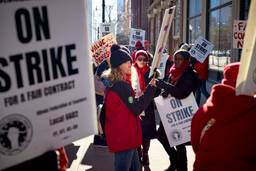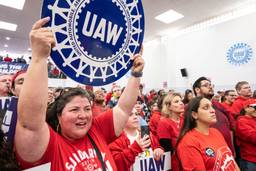
Two years after fast food workers in New York walked out of stores and restaurants throughout the city to demand $15 an hour and a union, their movement has grown and changed dramatically. That was evident on December 4, when fast food workers in approximately 190 cities went out on strike, according to organizers — the largest number so far.
In addition, since the “Fight for 15” came at a time of continuing decline in real wages for most Americans, the workers’ demands have triggered new, broad-based campaigns that are winning much higher minimum wages than anyone dreamed possible in many states and localities. Organizers claim that in large part thanks to this spreading campaign, nearly 7 million workers have received significant pay raises.
But the workers’ reliance on direct action, including civil disobedience that started last year and has been part of many protests and strikes since, has also inspired workers from other industries to join in, especially low-wage service workers who are largely interchangeable in the job market.
For example, according to organizers, as workers went out on strike at the super-sized “Rock ‘n Roll McDonald’s” in downtown Chicago during today’s actions, a convenience store clerk at a nearby BP station who had witnessed such protests before walked off his job and joined the fast food workers. Around the country, organizers said that burger cooks and cashiers were joined not only by convenience store workers but also home care aides, airport workers, dollar store and Walmart clerks, federal contract workers and even some adjunct professors.
The tone of the protests has changed in some ways, as well. While many workers are still reluctant to join in the fight for fear of losing their job, unstable and low-paying though it may be, the campaign’s success in using community support to keep strikers from losing their jobs “set the tone for workers in New York that management would have to deal with the community,” says New York City’s Fast Food Forward organizing director Kendall Fells. (The campaign has different names in different cities, such as Fast Food Forward in New York or, in Chicago, Fight for 15 — the project of an independent union, the Workers Organizing Committee of Chicago.) And protestors seem almost as likely to emphasize having a union as to focus on the obviously popular goal of winning pay increases to $15 an hour (and 40-hour weeks).
Most important, they seem to feel more hopeful and powerful. Dora Peña, a 56-year old grandmother who has worked eight years at a Chicago McDonald’s (and who has one daughter who also works for the company), still complains that “it’s impossible to make it on the pay we get.” Indeed, fast food workers rely on $7 billion a year in federal assistance to survive (effectively a taxpayer subsidy to companies that are extremely profitable and that pay top executives 1,200 times as much as average workers).
But she also told the crowd of 200 strikers in downtown Chicago on Thursday, “We’re here today because we’re winning. Fight for 15 has won concrete victories.” Besides the indirect increases in minimum wages, workers have raised pay in their stores, improved allocation of hours of work and reversed managerial discipline of workers.
So far the campaign has assumed that if workers could be “put in motion, then something good would come of it,” as one organizer said. At the very least, the public knows who fast food workers are now. “They’ve gone from invisible to invincible,” Fells says.
They have done it in part by “re-inventing the strike,” he says, much as Walmart workers have done. “When there’s no way of getting everyone involved, the mini-strike is designed to bring attention to workers and who they are.”
Now the campaign’s top strategists are moving ahead a step, trying to develop a “theory of how to win” on a grand scale, in the words of one organizer — an ongoing discussion within the Service Employees International Union (SEIU), the principal sponsor of the protests, since last year. Rather than having contracts for each store or even each franchisee, the fast food movement might strike a deal covering a leading corporation, such as McDonald’s, then try to spread it to the whole industry or even a broader sector of the economy.
One crucial development occurred earlier this year when the National Labor Relations Board general counsel ruled that McDonald’s Corporation was a joint employer of store workers along with the franchisee. That could make the corporation legally responsible for obeying wage laws and for being a party to collective bargaining agreements, and would open up the corporation’s deep pockets for pay and benefit increases.
As the campaign grows and hurts McDonald’s brand image, it may be cheaper for the company to settle fairly with workers than to lose customer respect. In its Securities and Exchange Commission filings this year, McDonald’s acknowledged that the protests could be financially damaging.
What would a union look like? First, Fells says, “It will be impossible to go through elections at all these individual stores. The labor movement is going to have to think of something new and fresh. The Fast Food Forward Way is direct action.” Recognition by direct action once was common, and it is more likely to lay the basis for worker involvement in the union than an election.
But the other side of the vision — agreements that cover an industry — are much more common in Europe than in the United States, in part because the law favors them more in most European countries that extend union-negotiated terms even to non-union companies.
Fast food workers can revive a long, if somewhat ancient, history of winning recognition by direct action, but they may have to be more inventive to create a workable industry-wide standard for fast food workers. It’s a tribute to the movement, though, that after just two years of organizing, the question is now open for debate.
David Moberg, a former senior editor of In These Times, was on staff with the magazine from when it began publishing in 1976 until his passing in July 2022. Before joining In These Times, he completed his work for a Ph.D. in anthropology at the University of Chicago and worked for Newsweek. He received fellowships from the John D. and Catherine T. MacArthur Foundation and the Nation Institute for research on the new global economy.







